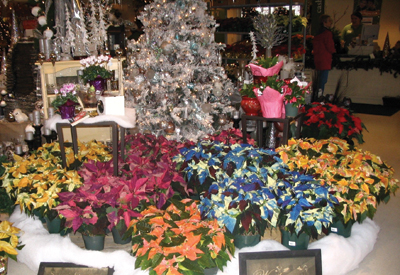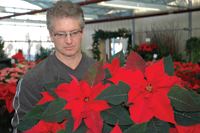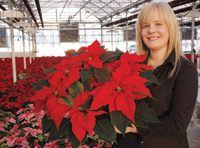
While the strength of poinsettia sales varied across the country this
past season, the consensus among growers is that they will be planting
fewer plants this year.
 |
|
| “Season’s Greetings” at one of the Sheridan Nurseries garden centres in the Toronto region
|
While the strength of poinsettia sales varied across the country this past season, the consensus among growers is that they will be planting fewer plants this year.
Production across Canada has been declining over the past few years. Over the past decade, the industry peaked in 2002, before dropping into single digits in 2005.
• 998 — 11 million pots.
• 1999 — 10.4 million.
• 2000 — 11.7 million.
• 2001 — 12.4 million.
• 2002 — 13.6 million.
• 2003 — 13.4 million.
• 2004 — 10.4 million.
• 2005 — 9 million.
• 2006 — 8.1 million.
• 2007 — 8.2 million.
 |
|
| Jim Hole, of Hole’s Greenhouses |
|
 |
|
| An impressive poinsettia display at one of the Sheridan Nurseries garden centres in the Toronto region. |
|
 |
|
| Nikki Stoyko, of Hole’s Greenhouses, with one of the garden centres’ red varieties. |
Peggy Godfrey, of Atlantic Gardens in Nova Scotia, for example, reports that poinsettia sales for them have been down for the past two years due largely to the loss of one major wholesale account. “We sold out what we grew this year,” she says, “but we may not grow any next year unless we can find more wholesale customers to make it profitable.”
Philip Pannekoek, of DeVry Greenhouses in Chilliwack, British Columbia, said their sales were fine, “but prices were a little lower than the preview year.” The company expects to grow about the same amount this year as they did in 2008.
Den Haan’s Garden Centre in Nova Scotia’s Annapolis Valley used to grow 12,000 poinsettias a year. This past year, the garden centre only grew 1,200 plants. “We reduced our production because of weak prices and the declining population in our area,” says Darlene den Haan.
In Québec, Michel Senecal, the province’s floriculture crop advisor, reports that while sales were quite strong – there were no snowstorms to interfere with sales, he notes – supply was limited because growers aren’t growing as much as they used to. “Consumers seem to be more interested in spending their money on electronics and other gift items.”
MORE LARGER POTS SOLD THAN SMALLER ONES
■ Karl Stensson, of Sheridan Nurseries in the Toronto area, reports that his company’s poinsettia sales were up this past season. “We sold more of the larger pots than smaller ones,” he adds.
Rick Rabb, general manager of CF Greenhouses in Leamington, Ontario, reports that his greenhouse operation grows about 190,000 poinsettias a season for sale mainly in the Toronto region. “Sales were about the same as last year,” he says of the season just passed. “We sold fewer 10” pots, but more of the smaller sizes.”
He notes that CF Greenhouses will be growing the same number of plants for the coming Christmas season.
In Manitoba, Vanderveen’s Greenhouses Ltd. in Carman (about 60 kilometres south of Winnipeg) sold out all of its poinsettias as it does every year. “The pricing is about the same every year,” notes Kelvin Vanderveen. “It’s tough getting any kind of sales increase.”
Priscilla Mah, of Central Botanical Gardens in Saskatoon, says they grew fewer poinsettias this past season and will probably grow even less this year.
Central Botanical Gardens supplies a number of chain stores and florists in Saskatchewan. “We grew 20,000 poinsettia plants this past year,” she says. “We will probably grow 19,000 this year,” she says, pointing to increased shipping costs as a factor in the decision.
‘POINSETTIAS HAVE BECOME MORE OF A COMMODITY.’
■ Bill Hole, of Hole’s Greenhouses in St. Albert, near Edmonton, reports his poinsettia sales were down by as much as 15 per cent this past season. He attributes the decline to increased competition. “Poinsettias have become more of a commodity,” he says. “So many places carry them now that they are losing their lustre and sense of uniqueness.”
Hole also observes that consumers don’t seem to be as tied to Christmas traditions as they used to be. “There is more of an interest in decorative hardwood and more creative floral designs,” he says.
“We will be cutting back on how many we plant this year.”
Having too much product late into the season makes it difficult to raise prices. “If you make them harder to find, people will put more value on them.”
On the West Coast, poinsettia sales were going very well, notes John Van Der Ende of Burnaby Lake Greenhouse, until a major snowstorm struck ten days before Christmas. “Until then, sales were better than last year.”
Red, of course, remains the most popular colour. “White was also relatively strong this past season,” Van Der Ende adds.
Priscilla Mah reports good demand for the ‘Ice Punch’ (red poinsettias with a frosty white centre) and ‘Jingle Bells’ (red with pink and white specks) varieties. There was also some interest in yellow Christmas cacti, she adds.
Kelvin Vanderveen says that 80 per cent of his sales were red poinsettias, with the remainder being white, pink and marble varieties.
While red is still strong in southern Ontario, Rick Rabb reports a stronger demand for other colours this past season.
CONSUMERS LOOK AT OPTIONS IN SEASONAL DECORATING
■ Karl Stensson adds that more customers bought wreaths and live branches for decorating the outsides of their homes.
In Québec, Michel Senecal reports that while growers tried other varieties, red was still the most popular colour.
Darlene den Haan said they sell about 75 per cent red “and the rest divided between pink, white and varieties.”
Den Haan and her staff received a surprise when half the poinsettia cuttings they planted last July turned out to have been incorrectly labelled. Some of the “reds” were actually other colours. “We certainly weren’t happy,” she says, “but we managed to sell them all.”
Den Haan’s Garden Centre had a lot of requests for azaleas. “We are considering adding some for next Christmas.” ■
Myron Love is a freelance writer and photographer in Manitoba.
Print this page